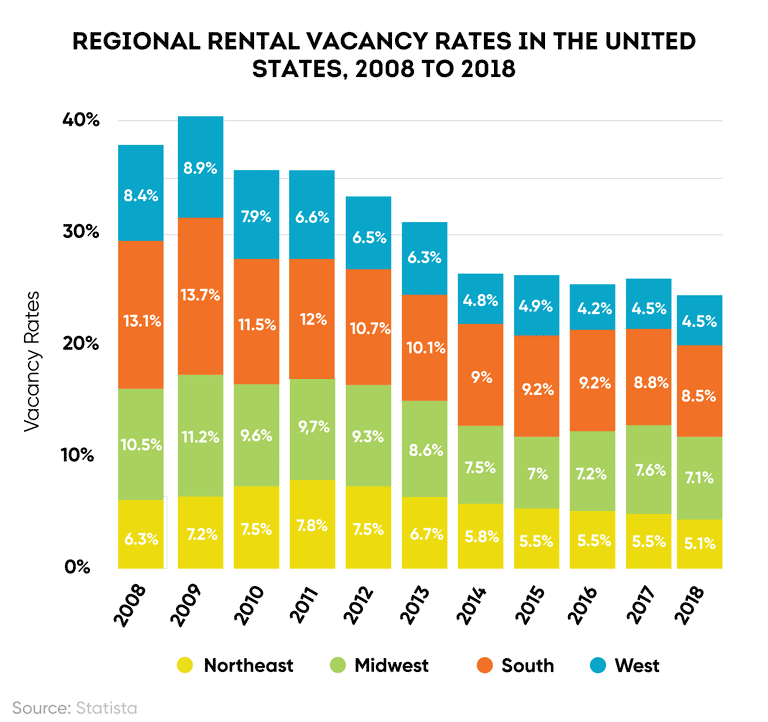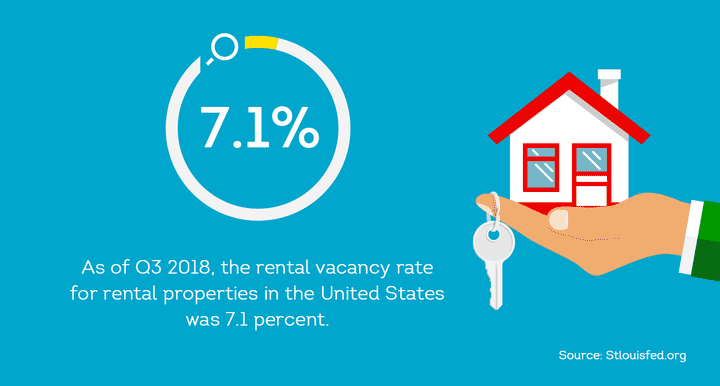Disclosure:
Remember that this material is intended to provide you with helpful information and is not to be relied upon to make decisions, nor is this material intended to be or construed as legal advice. You are encouraged to consult your legal counsel for advice on your specific business operations and responsibilities under applicable law. Trademarks used in this material are the property of their respective owners and no affiliation or endorsement is implied.
Avoiding rental property vacancy should be a priority for independent landlords, as tenant turnover can kill profitability, costing landlords thousands of dollars per month. The cost of tenant turnover is steep, as fees associated with damage repair, rental listing costs, and applicant screening add up quickly—and those expenses are just the tip of the iceberg.
According to SmartMove research, the total average cost of a vacant property can reach up to $1,750 a month. With so much money on the line, landlords are challenged to boost retention rates and keep their properties filled with high-quality, high-paying tenants for as long as possible.
Let’s explore the definition of vacancy rate and examine the ways it can affect a landlord’s bottom line.
What is Vacancy Rate?
Traditionally, vacancy rate is used by hotels and apartment complex owners to measure the percentage of available units in a multi-unit property. However, landlords that rent out single-family homes and units should use vacancy rate a bit differently.
As FitSmallBusiness indicates, by viewing rental rates on a broader scale, landlords can analyze vacancy rate to determine market rental conditions in a particular area. When used in this context, vacancy rate can help answer the following question:
How many properties are available for rent compared to the total number of properties in the area?
If your market has high vacancy rates, it may indicate that the area isn’t appealing to renters. In contrast, if there are low vacancy rates in your area, there’s likely a large number of renters who want to find living spaces there.
Local amenities can make or break vacancy rates in a given area. For example, if your rental property is located near grocery and retail stores, a university, or large transportation center, you may find that there are more renters looking to live in the area due to the abundance of conveniences. If your rental property is located outside of town and lacks easy access to these luxuries, you may find it’s harder to get your rental property off the market.
Why am I dealing with high vacancy rates?
High vacancy rates can be the result of a variety of factors:
- You’re charging too much for rent: If your rental rates are too high, then you may find it difficult to fill vacant units, especially if there are similar units in the area that are more favorable. Additionally, overpriced rent could cause you to lose tenants already living in your property. Keep tabs on what comparable properties are renting for by using a site like Rentometer.com, or check out forums like BiggerPockets to see what landlords in your area are charging.
- You aren’t keeping up with maintenance requests: Landlords that fail to quickly and appropriately respond to tenant requests may deal with costly turnover more frequently. Whether a tenant is calling to report a leak or needs new batteries in the smoke detector, it’s important to address property maintenance and repair issues as they arise. By doing this you may help to keep your high-quality tenants happy and encourage them to renew their lease when the time comes.

- Your property doesn’t compete with comparable properties in the area: If you’re charging the same rental rates as other landlords in your area, but your property doesn’t offer the same amenities, you’ll likely deal with more vacancy issues. To determine the average rent price in your area, you’ll want to find out the rent for at least three properties that are comparable to yours. The number of bedrooms and square footage should be the same, and if possible, you should try to find units with similar amenities, such as a garage, in-unit washer and dryer, and patio or balcony space.
If your vacancy rate is high, consider how your property (and your rental rates) are stacking up against the competition.
- Does your property fail to provide amenities that nearby complexes offer?
- Are you charging more money for a 2-bedroom apartment than other landlords or property managers in your area?
If this is the case, you may need to reduce your rental rates or update your amenities to remain relevant in the rental market and keep high-quality (and high-paying) tenants from leaving.
When should landlords be concerned about vacancy rates?
Ultimately, a property owner could use vacancy rate as a metric for rental business performance. While vacancy rates may traditionally be thought of as a method for assessing individual property performance, such as hotel and motel nightly vacancy rate, it can also be used as an economic indicator of overall market health in the real estate industry.
What is the average vacancy rate?
Vacancy rates vary among types of properties and different parts of the country. The below chart shows regional vacancy rates across the United States from 2008 to 2018.

Vacancy rates can vary significantly between different areas of a single city. According to FitSmallBusiness, a good vacancy rate measures somewhere between 2 and 4 percent in a metropolitan area. However, vacancy rates tend to be higher in rural areas.
As of Q3 2018, the rental vacancy rate for rental properties in the United States was 7.1 percent.

How to Determine Vacancy Rate
There’s no single way to determine vacancy rate when viewing it through the lens of rental market conditions. BiggerPockets outlines three different resources landlords can use to determine vacancy rate in their area.
1. Property Managers
Landlords can use local property managers or landlords as a resource. Speak to landlords in your area about vacancy rate and ask what they’re currently experiencing. These individuals may be able to give you more specific information about vacancy rates in particular neighborhoods.
2. Real Estate Agents
Landlords may consider hiring a real estate agent to discover more details about vacancy rate in a given area. Some real estate agents may conduct a comparative market analysis on local rental property statistics, which will indicate how long properties currently available on the MLS have sat vacant, along with other key pieces of information, including:
- How long properties were vacant before being rented
- Original listing prices compared to final renting prices
3. Census Data
The U.S. Census Bureau reports vacancy rates in various parts of the United States, including the largest 75 markets in the country. However, Census data doesn’t track the vacancy rate of specific neighborhoods, so it may not provide a precise number for your specific rental market area.
Tips on How to Decrease Your Vacancy Rate
Generally, a low vacancy rate is indicative of a well-performing property. If you want to decrease vacancy rate in your property, keep these helpful tips in mind:
1. Respond to tenant requests
Happy tenants are the key to maintaining a low vacancy rate. Keep loyal tenants by responding quickly to requests and making repairs in a timely fashion.
2. Offer more desirable amenities
Consider updating your rental property to offer the amenities that tenants want. From in-unit laundry to high-speed internet and smart home technology, there are plenty of features that may help you convince tenants to stay—or to rent from you in the first place. Again, the more up-to-date and in-demand amenities you have to offer, the more aggressive you may be able to get with your rental price.
3. Provide incentives for lease renewal or longer duration
To encourage longer leases, you might consider offering a discount in exchange for a longer lease term. For example, if you charge $1,000 per month for a 12-month lease, then you could consider dropping the rent to $950 for a 24-month lease. If your tenants gave notice that they are leaving and you want to retain them, then provide an incentive for them to stay. For example, you might offer a reduction in one month’s rent if a tenant renews their lease. Alternatively, you could offer certain property upgrades requested by the tenant upon renewal.
4. Find the right tenants from the start
To help decrease tenant turnover and rental property vacancy down the road, it’s crucial to find high-quality tenants from the start. Using tenant screening services like SmartMove can help you weed out unqualified applicants and place the right person in your property.
With comprehensive and compliant tenant screening reports, you can gain insight into a prospective tenant’s credit, criminal, and eviction history. SmartMove also delivers a ResidentScore, which predicts the risk of eviction 15% better than a general credit score. ResidentScore is designed specifically for the tenant screening industry and is exclusive to SmartMove.
While vacancy rates may primarily be influenced by market conditions and fair market rent prices, it’s important to acknowledge that eviction could also leave a landlord dealing with an unwanted vacant property as well. In a TransUnion survey, 84% of landlords said that payment problems were one of their top concerns, which is rightfully so when the average cost of eviction due to the nonpayment of rent is $3,500 and can take 3-4 weeks to complete. With SmartMove, landlords can learn more about a tenant’s ability to handle rent payments with Income Insights, a model that analyzes the applicant’s self-reported income by using data from the credit report. If Income Insights estimates your applicant’s income may be lower than what they reported, you’ll know you need to do additional income verification.
With comprehensive online screening, you can gain insight into a prospective tenant’s credit, criminal, and eviction history. Take advantage of ResidentScore to help predict the risk of renting to a particular applicant, and learn more about a tenant’s ability to handle rent payments with Income Insights.
Final Notes
High vacancy rates may indicate your rental isn’t performing as well as it could be. For landlords, finding the right tenants from the start is the key to promoting retention and increasing rental income.
Placing a good tenant in your property is a crucial element of landlord profitability, and thoroughly screening your prospective tenant with SmartMove can help you to make a more informed and confident leasing decision. It pays to use a convenient, compliant online screening to vet your tenants and reduce the risk of turnover and vacancy issues in the long run.
Know your applicant.
Additional Disclosure:
Remember that this material is intended to provide you with helpful information and is not to be relied upon to make decisions, nor is this material intended to be or construed as legal advice. You are encouraged to consult your legal counsel for advice on your specific business operations and responsibilities under applicable law. Trademarks used in this material are the property of their respective owners and no affiliation or endorsement is implied.



